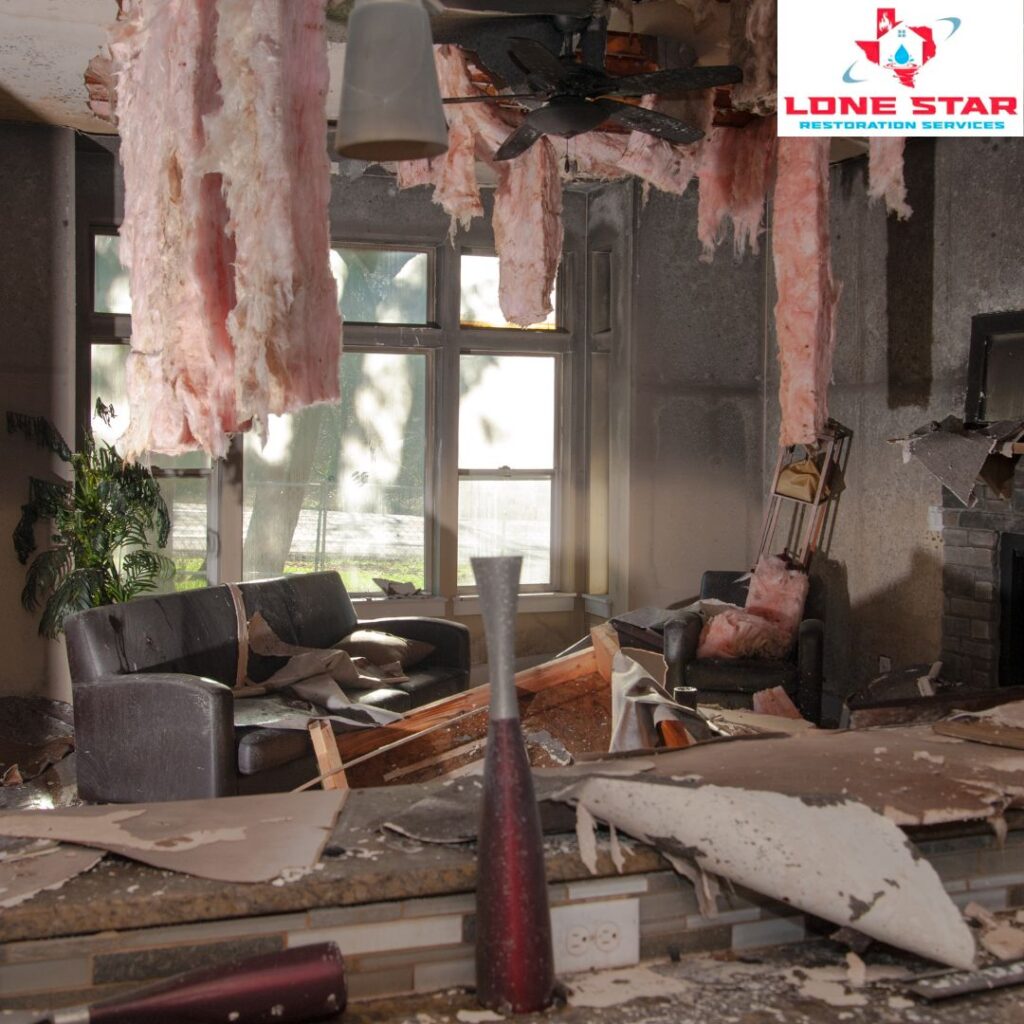The Definitive Handbook for Fire Damage Restoration: Steps to Take Following a Fire
A house fire is a devastating event that can leave families feeling overwhelmed, disoriented, and emotionally drained. In the wake of such a crisis, knowing what steps to take is essential to rebuilding your life and your home. That’s why we’ve prepared “The Ultimate Guide to Fire Damage Restoration: What to Do After a Fire.” In this comprehensive guide, we’ll walk you through the critical actions to take in the aftermath of a fire, from assessing the damage to rebuilding and preparing for the future.
The aftermath of a fire can be a daunting and confusing time. Your home may have suffered significant damage, and you may be grappling with a sense of loss and uncertainty. But rest assured, you’re not alone. Lone Star Restoration is here to provide you with expert guidance and support as you embark on the journey to restore your home and your peace of mind.
In the following sections, we’ll cover everything you need to know about post-fire recovery, including assessing the damage, contacting professionals, navigating insurance claims, salvaging your belongings, structural restoration, and steps to prevent future fires. By the end of this guide, you’ll be well-prepared to take the necessary actions and make informed decisions to expedite the restoration process and begin rebuilding your life.
Assessing the Damage
In the aftermath of a fire, the first step is to assess the extent of the damage. This crucial task requires caution and a methodical approach to ensure both your safety and an accurate evaluation of the situation.
A. Prioritize Safety
- Wait for Clearance: Before entering the fire-damaged property, wait for official clearance from firefighters or relevant authorities. Structures may still be unstable, and hazardous conditions may persist.
- Protective Gear: When you do enter, wear appropriate protective gear such as gloves, safety goggles, and a dust mask to guard against potentially harmful residues.
- Inspect for Hazards: Be vigilant for hazards like gas leaks, exposed wires, or weakened structural elements. If you suspect any of these dangers, leave the premises immediately and contact professionals.
B. Initial Assessment
- Document Damage: Begin documenting the damage by taking photographs and notes. These records will be essential for insurance claims.
- Assess Structural Integrity: Determine whether the structure of your home has been compromised. Pay particular attention to the roof, walls, and foundation.
- Check Utilities: Shut off utilities like gas, water, and electricity if they haven’t already been disabled by emergency services.
- Assess Smoke and Soot Damage: Smoke and soot can cause hidden damage. Inspect HVAC systems, ductwork, and vents for residue.
C. Contact Professionals
- Fire Damage Restoration Experts: Reach out to experienced fire damage restoration professionals, like Lone Star Restoration, to assess the situation comprehensively and initiate the restoration process.
- Insurance Company: Notify your insurance company about the fire and your intention to file a claim. Provide them with preliminary documentation.
Remember that assessing fire damage is a critical first step, and doing it methodically sets the stage for a smoother restoration process. The next step is to contact professionals who can guide you through the journey of rebuilding your home and your life.
Contacting Professionals
After a fire, one of the most crucial steps in the recovery process is reaching out to experienced professionals who specialize in fire damage restoration. These experts can provide the necessary guidance, assessment, and services to help you navigate the challenging journey ahead.
A. Why Professional Assistance is Vital
- Expertise and Experience: Fire damage restoration professionals have the expertise and experience to assess the extent of the damage accurately. They understand the nuances of fire damage, including hidden issues that may not be immediately visible.
- Safety First: Professionals prioritize safety. They are trained to identify potential hazards, structural weaknesses, and other risks, ensuring that the restoration process is carried out safely.
- Efficiency: Restoration experts can work efficiently to mitigate further damage and salvage as much as possible. Their prompt response can prevent secondary issues like mold growth or corrosion.
B. Choosing the Right Restoration Company
- Research and Referrals: Start by researching local restoration companies. Seek referrals from friends, family, or your insurance company for reputable options.
- Licensing and Certification: Ensure that the company is licensed, insured, and certified in fire damage restoration. These credentials demonstrate their commitment to quality work.
- Assessment and Estimation: Contact a few companies for on-site assessments and estimates. Compare their proposed restoration plans, timelines, and costs.
- Ask Questions: Don’t hesitate to ask questions about their process, previous experience with fire damage restoration, and any warranties they offer.
C. Contact Lone Star Restoration
At Lone Star Restoration, we understand the unique challenges you face after a fire. Our team of experienced professionals is ready to assist you every step of the way. From the initial assessment to the final restoration, we prioritize your safety, well-being, and the full recovery of your home.
Once you’ve assessed the damage and contacted professionals, you’re on the path to rebuilding your life and your property. In the next section, we’ll delve into the essential aspects of dealing with insurance claims to help you navigate this often complex process effectively.
Insurance Claims
Dealing with insurance claims can be a daunting process, but it’s a crucial step in your fire damage restoration journey. Properly managing your insurance claim ensures you receive the financial support needed to rebuild your home and replace your belongings.
A. Initiating the Claim Process
- Prompt Notification: Contact your insurance company as soon as possible after the fire. Most policies require prompt reporting of the incident.
- Provide Detailed Information: Be prepared to provide detailed information about the fire, including its cause and the extent of the damage. Use the documentation you gathered during the initial assessment.
B. Documenting Losses
- Inventory Your Belongings: Create an inventory of damaged or destroyed items, including their estimated value, purchase date, and any receipts or photographs you have.
- Temporary Living Expenses: Keep track of expenses related to temporary housing, meals, and other necessities. Many insurance policies cover additional living expenses during the restoration process.
C. Working with Adjusters
- Cooperate with Adjusters: Your insurance company may send an adjuster to assess the damage. Cooperate fully and provide them with access to your property and documentation.
- Review the Settlement: Once your claim is processed, review the settlement offer carefully. If you have questions or concerns, don’t hesitate to discuss them with your insurance company.
D. Avoiding Common Pitfalls
- Understand Your Policy: Familiarize yourself with your insurance policy to know what is covered and any limitations or exclusions.
- Beware of Public Adjusters: While some public adjusters can be helpful, be cautious about signing agreements with them without understanding their fees and terms.
Salvaging and Cleaning
While the insurance claim process is underway, you can take steps to salvage what remains and begin the cleaning process.
A. Salvaging Valuables
- Priority Items: Start by salvaging priority items like important documents, sentimental items, and valuables.
- Protection from Further Damage: Protect salvageable items from further damage by moving them to a safe location.
B. Cleaning and Deodorizing
- Professional Cleaning: Smoke and soot can permeate surfaces and fabrics. Hire professionals for thorough cleaning and deodorizing to eliminate odors and health hazards.
- Ventilation: Open windows and use fans to ventilate the space and remove lingering odors.
Structural Restoration
Restoring the structural integrity of your home is a complex and crucial phase of fire damage recovery.
A. Structural Assessment
- Comprehensive Evaluation: Work with your chosen restoration professionals to conduct a thorough structural assessment.
- Addressing Weakened Areas: Identify and address weakened or damaged areas, including walls, ceilings, and the foundation.
B. Restoration Techniques
- Rebuilding: Depending on the extent of damage, restoration may involve rebuilding parts of your home, including drywall, roofing, and flooring.
- Repairs and Repainting: Repairing and repainting damaged surfaces can restore the aesthetic and functionality of your home.
Prevention and Future Preparedness
As you near the completion of the restoration process, it’s essential to consider measures to prevent future fires.
A. Fire Prevention
- Smoke Alarms and Detectors: Ensure your home is equipped with functioning smoke alarms and detectors.
- Fire Extinguishers: Have fire extinguishers strategically placed in your home, and learn how to use them.
- Safe Cooking Practices: Follow safe cooking practices to reduce the risk of kitchen fires.
B. Emergency Plan
- Escape Plan: Develop and practice a fire escape plan with your family, including designated meeting points outside the home.
- Emergency Contacts: Keep a list of emergency contacts, including fire department, insurance company, and restoration professionals, readily available.
C. Fire-Resistant Materials
- Consider Upgrades: When restoring your home, consider using fire-resistant materials for added protection.
- Landscaping: Maintain a defensible space around your home by trimming trees and bushes and removing flammable debris.
In conclusion, recovering from a fire is a challenging journey, but with the right guidance and professionals by your side, you can rebuild your home and your life. Lone Star Restoration is committed to helping you every step of the way. Our team is dedicated to ensuring your safety and the full restoration of your property.
If you’ve experienced a fire and need assistance with the restoration process, please don’t hesitate to reach out to us. We’re here to support you during this difficult time and help you restore your home to its former glory.
Conclusion
Recovering from a fire is a challenging and emotional journey, but by following the steps outlined in “The Ultimate Guide to Fire Damage Restoration: What to Do After a Fire,” you can navigate this difficult process with confidence. From the initial shock of the fire to the final stages of structural restoration and future preparedness, each step is essential to your recovery.
Remember, you don’t have to face this journey alone. Lone Star Restoration is here to provide the expertise, support, and professional services you need to rebuild your home and your life. Our experienced team understands the complexities of fire damage restoration, and we are dedicated to ensuring your safety and the successful restoration of your property.
As you embark on the path to recovery, take it one step at a time, and don’t hesitate to reach out to professionals for assistance. Your home can be restored, and with the right guidance, it can become a safe and welcoming place once again.
We hope this guide has been a valuable resource for you during this challenging time. If you have any questions or require immediate assistance with fire damage restoration, please contact Lone Star Restoration. We’re here to help you every step of the way.





